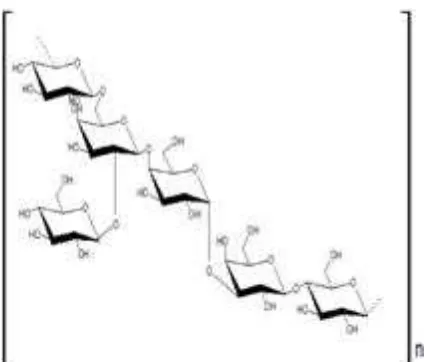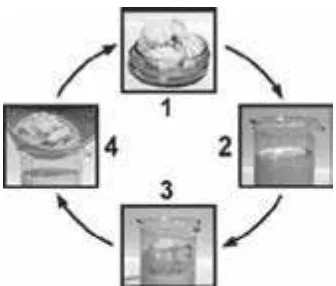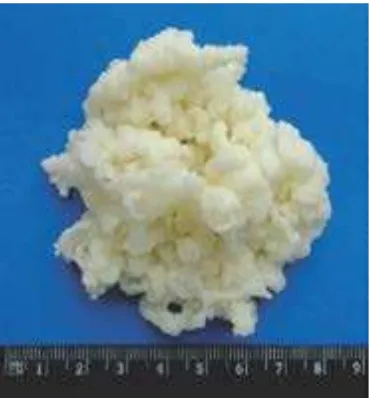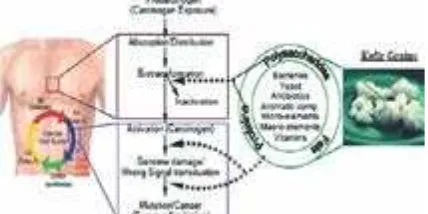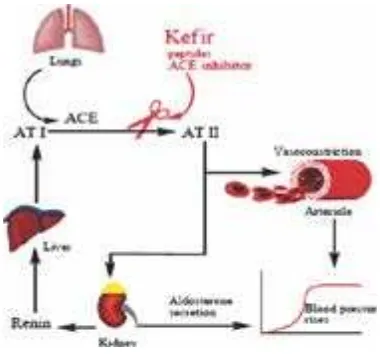Jurnal Kedokteran dan Kesehatan Indonesia
Indonesian Journal of Medicine and Health
Journal homepage : www.journal.uii.ac.id/index.php/jkki
A B ST R AC T
*Corresponding author:
hannytan18@gmail.com A RT I C L E I N FO
Kefir: a new role as nutraceuticals
Hanny Setyowati*1 , Wahyuning Setyani21Department of Research and Development, Borobudur Natural Industry, Semarang 2 Faculty of Pharmacy, Sanata Dharma University, Yogyakarta
Keyword:
nutraceutical kefir composition
therapeutic properties health
DOI : 10.20885/JKKI.Vol7.Iss5.art5
Nutraceutical is the fusion of “nutrition” and pharmaceutical”. This products,
in broad, are food or part of food that provides medical or health benefits including the prevention and or treatment of a disease. Kefir is renowned
nutraceutical dairy products produced through fermentation of bacteria and
yeasts and naturally present in grains of kefir. The nutritional attributes are
due to presence of vital nutrients such as carbohydrates, amino acids, proteins, minerals, phosphorus, vitamin, calcium, and certain biogenic compounds. Intestinal immunity, antimicrobial, anticarcinogenic, hypocholesterolemic effect, antibiabetic, effect on blood pressure level, antioxidant, wound healing, and lactose intoleran can be achieved using this products. The purpose of this review is to gather information about composition, methods of production,
and therapeutic properties of kefir products to provide justification for its consumption. This review confirms that kefir can be a new role of nutraceutical
products.
Nutraceutical merupakan perpaduan antara aspek “nutrisi (nutrition) dan farmasi (pharmaceutical)”. Sediaan ini, secara luas, didefinisikan sebagai makanan atau bagian dari makanan yang memiliki manfaat terhadap kesehatan, yakni dalam hal pencegahan dan pengobatan penyakit. Kefir dikenal sebagai produk nutraceutical yang berasal dari fermentasi bakteri atau ragi yang secara alami terdapat pada tiap butiran kefir. Kandungan nutrisi pada kefir terdiri dari karbohidrat, asam amino, protein, mineral, fosfor, vitamin, kalsium, dan senyawa biologis lainnya. Imunitas saluran cerna, antimikroorganisme, antikanker, efek hipokolesterolemia, antidiabetes, efek terhadap penurunan tekanan darah, antioksidan, penyembuh luka, dan intoleran laktosa dapat ditangani dengan mengkonsumsi produk ini. Tujuan penulisan artikel ini adalah untuk mengumpulkan informasi terkait dengan komposisi, metode pembuatan, dan karakteristik terapi dari produk kefir pada saat digunakan. Artikel secara keseluruhan menegaskan bahwa kefir dapat berperan sebagai agen nutraceutical.
INTRODUCTION
Nutraceuticals are a diverse product category with various synonyms used internationally. The term nutraceuticals were coined from “nutrition” and “pharmaceutical” by Stephen Defelice MD, founder and chairman of the foundation for innovation in medicine (FIM) Cranford, New Jersy,
in 1989. According to Defelice “nutraceuticals are food or part of a food that provides medical or
health benefits including the prevention and/or
treatment of a disease” 1,2. Other words used in
ingredients that incorporated into giving them
a specific medicinal or health benefit moreover
nutritional effect 3.
NUTRACEUTICAL CATEGORIES
Due to minimal international regulations different types of products fall under the nutraceutical category. Because of this some of
them have overlapping definitions. The most
usual are herbals, dietary supplements, functional food and products labeled “nutraceutical”. These can be grouped into the following three broad categories:
1. Nutrients: Substances with established nutritional functions, such as vitamins, minerals, amino acids and fatty acids. 2. Herbals: Herbs or botanical products as
concentrates and extracts.
3. Dietary supplements : Reagents derived from other sources (e.g. pyruvate, chondroitin sulphate, steroid hormone precursors)
serving specific functions, such as sports
nutrition, weight-loss supplements and meal replacements 4.
Das et al.5 also organize nutraceutical in several
ways depending upon its easier understanding and application, i.e. for academic instruction, clinical trial design, functional food development or dietary recommendations. Some of the most common ways of classifying nutraceuticals can be based on food sources, mechanism of action, chemical nature etc. The food sources used as
nutraceuticals are all natural and classified as:
1. Dietary Fibre 2. Probiotics 3. Prebiotics
4. Polyunsaturated fatty acids 5. Antioxidant vitamins 6. Polyphenols
7. Spices
KEFIR
Kefir (or known as kefiran) is an EPS classified
as a heteropolysaccharide comprising glucose and galactose in high concentrations, and it
is classified as a water-soluble gluco galactan,
which makes it suitable to be used as an additive
6 (Fig. 1). Exopolysaccharides (EPSs) of microbial
origin are long chain, high-molecular-mass water-soluble polymers which may be ionic or non-ionic and have potential applications
in food industries as texturizers, viscosifiers, emulsifiers and syneresis-lowering agents due
to their pseudoplastic rheological behaviour and water-binding capacity 7. Kefiran has excellent
rheological properties and can significantly
improve the viscosities of lacteous products by favoring and maintaining gel properties and avoiding the loss of water during storage.
With respect to the biological activity of kefiran, several studies have demonstrated that this EPS
can be used as a nutraceutical 8.
Figure 1. Kefir structure 8
Origin of kefir
Kefir is a viscous, slightly carbonated dairy
beverage that contains small quantities of alcohol and, like yoghurt, is believed to have its origins in the Caucasian mountains of the former USSR. It is also manufactured under a variety of names including kephir, kiaphur, kefer, knapon, kepi, and kippi9. It is not clear whether all kefirs
originate from a single original starter culture
since microbial analyses of kefir samples taken from different locations indicate microflora
population differences10.
homofermentative Lactobacillus species and yeasts, is a branched polysaccharide containing equal amounts of glucose and galactose. The
kefir grain contains lactococci, leuconostocs, thermophilic and mesophilic lactobacilli, yeasts
(lactose negative and lactose positive), and acetic acid bacteria. These microorganisms maintain
a symbiotic life in kefir grain. In this microflora,
there are lots of microorganisms such as Lb. brevis, Lb. kefir, Lb. acidophilus, Lb. bulgaricus, Lb. casei, Lb. kefiranofaciens, Lb. helveticus,
Lactococcus lactis subsp. lactis, and Lactococcus
lactis subsp. Cremoris11. Yeast was isolated from
kefir were identified as Kluyveromyces marxianus, Kluyveromyces wickerhamii, Saccharomyces cerevisiae, Pichia angusta, Pichia guilliermondii,
Candida glaebosa. Kluyveromyces marxianus
was identified in the isolates from all the kefir
samples, followed by Kluyveromyces wickerhamii.
Pichia angusta, Pichia guilliermondii, Candida glaebosa 12.
Kefir production
The traditional way of producing kefir is using
raw unpasteurized, pasteurized, or UHT treated milk. The milk is poured into a clean suitable
container with the addition of kefir grains, the
content is left to stand at room temperature for approximately 24 hours. The cultured-milk
is filtered in order to separate and retrieve the milk grains from the liquid-kefir. This fermented
milk is appropriate for consumption. The grains are added to more fresh milk and the process is simply repeated. This simple process can be
performed on an indefinite basis, since kefir
grains are a living ecosystem complex that can be preserved forever as long as it is feeded. As
active kefir grains are continually cultured in fresh milk to prepare kefir, the grains increase
in volume or in biological mass 13,14 (Fig. 2).
Dailin et al 15 found that the optimum
medium for production was composed of (g/L): lactose, 50.0; yeast extract, 12.0; KH2PO4, 0.25; sodium acetate, 5.0; Triammonium citrate, 2.0; MgSO4.7H2O, 0.2; MnSO4.5H2O, 0.05. This new
medium formula not only increased the kefiran
volumetric production from 0.23 up to 1.29 g/L
but also shorten the production time from 72
hours to only 60 hours. The kefir grain biomass increased significantly by addition of mineral
sources and vitamins in conventional medium, using organic milk as culture medium and incubation parameters: 24 hours at 25°C with agitation rate at 125 rpm 16. Another studies
by Purnomo et al17 and Lengkey et al18 resulted
that the optimum of milk kefir can be prepared with 7% (w/v) and 10% (w/v) Indonesian kefir
grains and incubation time of 24 hours.
Figure 2. Kefir production. Kefir grains (1) are added to milk, (2) are left to stand at room temperature for fermentation 18-24 h, (3) after which they are filtered, (4) and ready to start another cycle. The fermented milk that results form step 4 is appropriate for consumption13
Kefir product also can be made from a mixture of water, dried figs, a slice of lemon and sucrose. The water kefir was prepared in
a sucrose solution (100 g/l) in 1 l tap water
containing two dry figs and a slice of organic lemon. The predominant genus in water kefirs
was Lactobacillus, which the most abundant species were Lb. hordei and Lb. nagelii followed by considerably lower numbers of Lb. casei19.
Characteristics of Kefir
The kefir grains are insoluble in water and
common solvents, gelatinous and irregular in
size, varying from 0.3-3.5 cm in diameter. Kefir grains resemble small cauliflower florets: they
measure 1-3 cm in length, are lobed, irregularly shaped, white to yellow-white in color, and have
viable by transferring them daily into fresh milk and allowing them to grow for approximately 20 hours; during this time, the grains will have
increased their mass by 25%. Grains must be
replicated in this way to retain their viability,
since old and dried kefir grains have little or no
ability to replicate 20.
Identification the kefiran (extracted from kefir grains) using FTIR spectroscopy showed
that the structural integrity was maintained in
biofilms. The best characteristics (transparency and elasticity) obtained from kefiran solution
with 7.5% w/w glycerol 21.
Figure 3 Physical appearance of a typical kefir grain 20
Composition of kefir
Kefir has the high levels of nutritional
value, such as amino acids, proteins, minerals, phosphorus, vitamin, and calcium. Suriasih et al. 22 have observed the chemical composition
of pasteurised Bali cattle milk. Kefir prepared
through 24 hours fermentation showed the highest microbial population, lactose content and pH, but the lowest titratable acidity and protein concentration. There were two species of lactic
acid bacteria found in kefir samples, namely,
Lactobacillus paracasei and Lactobacillus brevis,
and only one species of yeast, namely Candida
famata was identified from the kefir samples in
this study. Lactobacillus paracasei represented
the largest and most commonly identified LAB
isolates, with 89 of a total of 249 isolates, followed
by Lactobacillus parabuchneri (41 isolates),
Lactobacillus casei (32 isolates), Lactobacillus
kefiri (31 isolates) and Lactococcus lactis (24
isolates) in the Brazilian kefir. Lactobacillus kefiri
is another important bacterium found during
kefir fermentation. There are reports on the
presence of Lactobacillus kefiri as a prevailing member of the lactic acid microbiota in milk
kefir 23. The FAO/WHO (2001) have proposed
a definition of kefir based on the microbial composition of both kefir grains (the starter culture used to produce kefir) and the final kefir
product (see Table 1).
Table 1 Codex Alimentarius description of kefir
Definition
Starter culture prepared from kefir grains,
Lactobacillus kefiri, and species of the genera
Leuconostoc, Lactococcus and Acetobacter
growing in a strong specific relationship. Kefir
grains constitute both lactose-fermenting yeasts (Kluyveromyces marxianus) and non-lactose-fermenting yeasts (Saccharomyces unisporus, Saccharomyces cerevisiae and Saccharomyces exiguus).
Composition
Milk protein (% w/w) min. 2.8
Milk fat (% m/m) <10
Titratable acidity, expressed as % of lactic acid(% m/m)
min. 0.6
Ethanol (% vol./w) not stated
Sum of specific microorganisms
constituting the starter culture (cfu/g, in total)
min. 107
Yeasts (cfu /g) min. 104
THERAPEUTIC PROPERTIES Intestinal immunity
Kefir colonizes in the intestine and produces
host’s immune reactivity. Lactobacillus species
isolated from kefir have the capacity to resist
oxgall and many of them are able to adhere to enterocyte like cells24.
Probiotics are live microorganisms which
exert a benefit effects on the host. The Food
and Agriculture Organization of the United
Nations defines them as “live microorganisms
which when administered in adequate amounts
confer a health benefit on the host”. Members of general Lactobacillus and Bifidobacterium
are the most common probiotics used not only for human consumption but also in pharmaceutical preparations or in biomedicine25.
One of the main criteria for selection of oral administration of probiotics is their ability to adhere to the intestinal mucosa allowing a transitory colonization of the gastrointestinal tract. Probiotics maintain the balance within such complex ecosystem as human intestine in many ways: inhibition of the proliferation of pathogens by competition between bacteria and pathogens for adhesion, suppression of production of virulent factors by pathogens secreting bacteriocins, or modulation of the host immune system via interaction between probiotic bacteria and intestinal epithelial cells 26.
Bekar et al 27 found that kefir improves
eradication rates in patients infected with Helicobacter pylori treated by triple therapy during 14-days. This product can enhances
the specific intestinal mucosal immune
response against cholera holotoxin. Increased immunoglobulin secretion appears to be associated with a higher number of antibody-secreting cells in the gut-associated lymphoid tissues. These probiotic foods may have a
common adjuvant effect on the mucosal immune
system 28.
Antimicrobial activity
Kefir possesses antimicrobial activity in vitro against a wide variety of Gram-positive and Gram-negative bacteria, as well as some fungi. Some coliforms are actively inhibited by kefir
microorganisms, and pathogenic bacteria such as Candida albicans, Salmonella typhi, Shigella
sonnei, Staphylococcus aureus, and Escherichia
coli 29. The exact cause of inhibition is not known,
but may be due to the antagonist action of various species of LAB (Lactic Acid Bacteria), which are also capable to preventing the adherence, establishment, replication, and/or pathogenic action of certain enteropathogens which related to their function as probiotics 30.
Anticarcinogenic Activity
The anticarcinogenic role of fermented dairy
products like kefir, can be attributed to cancer
prevention and the suppression of early-stage tumors. The bioactive components in fermented milk have the capacity to prevent the cancer initiation (antimutagenic); these also work by suppressing the initiated tumor growth by hindering certain enzymes so that conversion of procarcinogen to carcinogen is eliminated
31. Kefir which made from milk and soymilk
showed significant antimutagenic by reducing
the glutathione peroxidase activity 32. The other
mechanism by which cancer initiation process slows down is the activation of the immune system (Fig. 4).
Figure 4 Tumor formation in body and proposed sites of action of kefir 31
Hypocholesterolemic Effect
Hypolipidemic nutraceuticals help improve
serum lipid profiles as reducing total cholesterol,
triglyceride, and low-density lipoprotein cholesterol, while elevating high-density lipoprotein cholesterol 33,34. Possible mechanisms
proposed for the hypocholesterolemic activity
in kefir may involve different ways: (i) through
free and deconjugating bile acids; (iii) inhibiting the enzyme HMG-CoA reductase.
Figure 5 Cholesterol biosynthesis pathway25
Two substances, i.e, orotic acids and/ or hydroxymethylglutaric are thought to restrict rate-limiting enzyme that is important in synthesis of cholesterol 35 (Fig. 5). The
mechanism of deconjugation of bile acids was
done by increasing the formation of new bile acids needed to replace those that have escaped the enterohepatic circulation, resulting in the decrease of serum cholesterol levels 36 (Fig. 6).
These findings demonstrate that kefir or its
components have greater potential to be used as hypocholesterolaemic substance.
Figure 6 (a) Chemical structure of bile acids. Bile acids are conjugated with either glycine or taurine prior to secretion; (b) Reaction catalyzed by bile salt hydrolase enzymes. BSHs cleave the peptide linkage of bile acids, which results in the removal of the amino acid group from the steroid core. The resulting unconjugated bile acids precipitate at low pH
Antidiabetic activity
Kefir that was produced in conjunction
with soymilk and Rhodiola extracts exhibited a better anti-diabetic functionality. This product mobilized the phenolics compounds, which alter the postprandial hyperglycemia 37. Consumption
of probiotic-fermented milk (kefir) in diabetic
patients in comparison with conventionally fermented milk decreased the fasting blood glucose and HbA1C levels. These probiotics affected gut bacteria to produce insulinotropic polypeptides and glucagon-like peptide-l so induce uptake of glucose by muscle. As well as liver stimulates the absorption of more blood glucose in the form of glycogen 38.
Effect on blood pressure level
Lactobacillus kefiranofaciens, isolated
from kefir grains, produces an extracellular
polysaccharide which can decrease the blood pressure in rats after 30 days 39. A commercial
kefir which made from caprine milk can
manage blood pressure in the presence of two out of sixteen peptides. This effect on blood pressure may be attributed to suppressing the
angiotensin-converting enzyme (ACE). ACE activity influences blood pressure through different means. ACE converts AT I to AT II. AT II
is a potent vasoconstrictor and it also stimulates aldosterone in kidney to retain more liquid in the body, thus increases blood pressure 40 (Fig. 7).
Antioxidant activity
Kesenkas et al. 41 evaluated antioxidant
activity of kefirs produced from full and half
fat cow/soy milk mixtures. The inhibition of ascorbate autooxidation from cow/soy milk
kefirs ranged from 8.34–17.00%, which related
to their reduction activity. Similarly with the ascorbate autoxidation ability and reducing
the activity of kefir samples, the superoxide
anion scavenging effect of samples showed satisfy results. It has been indicated that some Lactococcus spp. are responsible to expressing antioxidative enzyme superoxide dismutase activity.
Another study possessed that addition of
kefir grains to the goat milk, the DPPH radical
scavenging activity appeared to have increased.
The goat milk-kefir is a good scavenger for DPPH radical; thus, kefir can afford protection against
proton free radicals.42 The fresh water kefir drink
showed a high ability for inhibition ascorbate autoxidation, which attributed to its contains of lactic acid, acetic acid bacteria, and yeasts. It can referred to their simultaneously existing, and their intracellular and extracellular metabolites and also to the products of its cell lysis.43
Wound healing activity
Kefir gels had a protective effect on skin
connective tissue and 7 days treatment enhanced wound healing compared with 5 mg/kg of
neomycin–clostebol emulsion 44. This product
which prepared from an extract of continuously
cultured kefir grains, resulted the lower inflammation and the higher epithelization and
scar formation compared to conventional silver sulfadiazine treatment 45.
Lactose intoleran
The term lactose intolerance indicates that lactose malabsorption causes gastrointestinal symptoms. Lactose malabsorption occurs when a substantial amount of lactose is not absorbed in the intestine. These symptoms are common in the absence of lactose ingestion and are highly susceptible to the placebo effect. The
strategy to treat lactose intolerance is to restrict consumption of dairy foods containing lactose. Commercial products developed for lactose-intolerant persons include lactose-reduced milk and lactase supplements taken at the time of milk ingestion, one of them is fermented milk,
like kefir 46,47,48.
Kefir can reduce the perceived severity of flatulence by 54% to 71% relative to milk.
Abdominal pain and diarrhea symptoms were
negligible among the kefir treatment 49. Many
subjects with lactose intolerance can consume
milk and dairy products without getting symptoms and fermented milk products may be helpful in improving tolerance. Other individuals
do benefit significantly from lactose restriction
but care needs to be taken to ensure that calcium
intake is sufficient. A greater understanding of
the complexity of lactose intolerance, lactase
deficiency and symptom generation would help
clinicians treat patients more effectively 50.
CONCLUSIONS
Due to high nutraceutical and therapeutic
potential, kefir is ranked at top position. The characteristics in kefir are attributed to amino
acids, proteins, minerals, phosphorus, vitamin, calcium, and certain biogenic compounds. The
microbiota of kefir has especially affected kefir
grain from various origins and production
methods. The beneficial health associated with kefir are numerous, including, intestinal
immunity, antimicrobial, anticarcinogenic, hypocholesterolemic effect, antidiabetic, the effect on blood pressure level, antioxidant, wound healing, and lactose intolerance.
REFERENCES
1. Kalra EK. Nutraceutical-definition and in -troduction. Aaps Pharmsci. 2003;5(3): 27-35.
2. Palthur MP, Palthur SS, Chitta SK.
Nutraceu-ticals: a conceptual definition. Int J Pharm
Pharm Sci. 2010; 2 (3): 19-27.
3. Chauhan B, Kumar G, Kalam N, Ansari SH.
nutraceutical: A review. Journal of advanced pharmaceutical technology and research. 2013;4(1): 4-8.
4. Dev R, Kumar S, Singh J, Chauhan B. Poten-tial role of nutraceuticals in present scener-io: A review. Journal of Applied Pharmaceu-tical Science. 2011; 1 (4): 26-28.
5. Das L, Bhaumik E, Raychaudhuri U,
Chakraborty R. Role of nutraceuticals in human health. Journal of food science and technology. 2012;49(2):173-256.
6. Giavasis I. Production of microbial polysac -charides for use in food. Microbial
Produc-tion of Food Ingredients, Enzymes and Nu -traceuticals. 2013; 413-481.
7. Patel AK, Michaud P, Singhania RR, Soccol CR, Pandey A. Polysaccharides from pro-biotics: new developments as food addi-tives. Food Technology and Biotechnology. 2010;48(4): 451-514.
8. Prado MR, Blandón LM, Vandenberghe LP,
Rodrigues C, Castro GR, Thomaz-Soccol V, Soccol CR. Milk kefir: composition, micro -bial cultures, biological activities, and re-lated products. Frontiers in microbiology. 2015;6: 1-10
9. Gaware V, Kotade K, Dolas R, Dhamak K,
Somwnshis S, Nikam V, Khadse A, Kashid V.
The magic of kefir: a review. Pharmacology
online. 2011;1: 376-462.
10. Farnworth ER. Kefir–a complex probiotic.
Food Science and Technology Bulletin: Fu. 2006;2(1):1-7.
11. Kesenkas HA, Yerlikaya O, Ozer EL. A func
-tional milk beverage: Kefir. Agro Food In -dustry Hi Tech. 2013;24: 53-58.
12. Kıvanç M, Yapıcı E. Kefir as a Probiotic Dairy
Beverage: Determination Lactic Acid Bacte-ria and Yeast. International Journal of Food
Engineering. 2015;1(1): 55-60.
13. Lopitz-Otsoa F, Rementeria A, Elguezabal N, Garaizar J. Kefir: a symbiotic yeasts-bacte -ria community with alleged healthy capa-bilities. Rev Iberoam Micol. 2006;23(2): 67-74.
14. McGrew GN, Barkalow DG, Johnson SS, Re
-cord DW, Patel MM, Nimz JD, Zibell SE, Yatka RJ, Greenberg MJ, Aumann RA, Zyck DJ, in -ventors. Nutraceuticals or nutritional
sup-plements and method of making. United States patent US 6,949,264. 2005; 1-45.
15. Dailin DJ, Elsayed EA, Othman NZ, Malek RA,
Ramli S, Sarmidi MR, Aziz R, Wadaan MA,
Elenshasy HA. Development of cultivation medium for high yield kefiran production by Lactobacillus kefiranofaciens. Interna -tional Journal of Pharmacy and Pharmaceu-tical Sciences. 2015;7(3): 159-163.
16. Pop CR, Apostu S, Salanţă L, Rotar AM, Sindic M, Mabon N, Socaciu C. Influence of Differ
-ent Growth Conditions on the Kefir Grains Production, used in the Kefiran Synthesis.
Bulletin of University of Agricultural
Sci-ences and Veterinary Medicine Cluj-Napoca.
Food Science and Technology. 2014;71(2): 147-200.
17. Purnomo H, Muslimin LD. Chemical charac-teristics of pasteurised goat milk and goat
milk kefir prepared using different amount of indonesian kefir grains and incubation
times. International Food Research Journal. 2012;19(2): 791-794.
18. Lengkey HA, Siwi JA, Balia RL. The effect of
various starter dosages on kefir quality. Lu
-crări ̧tiinţifice-Universitatea de ̧tiinţe Ag
-ricole ̧i Medicină Veterinară, Seria Zooteh -nie. 2013;59:113-116.
19. Gulitz A, Stadie J, Wenning M, Ehrmann MA,
Vogel RF. The microbial diversity of water
kefir. International journal of food microbi -ology. 2011;151(3):284-292.
20. Prajapat JB, Patel A. Food and health appli -cations of exopolysaccharides produced by lactic acid bacteria. Advances in Dairy Re-search. 2013; 1(2): 1-7.
21. Pop C, Apostu S, Rotar AM, Semeniuc CA, Sindic M, Mabon N. FTIR spectroscopic
characterization of a new biofilm obtained from kefiran. Journal of Agroalimentary
Processes and Technologies. 2013;19:157-166.
22. Suriasih K, Aryanta WR, Mahardika G, As -tawa NM. Microbiological and chemical
properties of Kefir made of Bali cattle milk.
Food Science and Quality Management. 2012;6:2225-0557.
23. Magalhães KT, Pereira GV, Campos CR, Drag
microbial communities and chemical com-position. Brazilian Journal of Microbiology. 2011;42(2): 693-702.
24. Otles S, Cagindi O. Kefir: A probiotic
dairy-composition, nutritional and thera-peutic aspects. Pakistan Journal of Nutri-tion. 2003;2(2): 54-59.
25. Ciszek, M. Biological function of exopolysac-charides from probiotic bacteria. Central
European Journal of Immunology. 2011; 36
(1): 51-55.
26. Arslan S. A review: chemical,
microbiolog-ical and nutritional characteristics of kefir.
CyTA-Journal of Food. 2015;13(3): 340-345.
27. Bekar O, Yilmaz Y, Gulten M. Kefir improves the efficacy and tolerability of triple thera -py in eradicating Helicobacter -pylori. Jour-nal of mediciJour-nal food. 2011;14(4): 344-351.
28. Thoreux K, Schmucker DL. Kefir milk
enhances intestinal immunity in young but not old rats. The Journal of nutrition. 2001;131(3): 807-819.
29. Silva KR, Rodrigues SA, Xavier Filho L, Lima ÁS. Antimicrobial activity of broth
fer-mented with kefir grains. Applied biochem -istry and biotechnology. 2009;152(2): 316-341.
30. Adriana P, Socaciu C. Probiotic activity of
mixed cultures of kefir’s lactobacilli and
non-lactose fermenting yeasts. Bull. UASVM Agric. 2008;65: 329-363.
31. Ahmed Z, Wang Y, Ahmad A, Khan ST, Nisa
M, Ahmad H, Afreen A. Kefir and health: a
contemporary perspective. Critical reviews in food science and nutrition. 2013;53(5): 422-456.
32. Liu JR, Chen MJ, Lin CW. Antimutagenic and
antioxidant properties of milk-kefir and soymilk-kefir. Journal of agricultural and
food chemistry. 2005;53(7): 2467-2541.
33. Chen G, Wang H, Zhang X, Yang ST. Nutra -ceuticals and functional foods in the man-agement of hyperlipidemia. Critical reviews in food science and nutrition. 2014;54(9): 1180-1381.
34. Chen ZY, Jiao R, Ma KY. Cholesterol-low-ering nutraceuticals and functional foods. Journal of Agricultural and Food Chemistry. 2008;56(19): 8761-8834.
35. Leite AM, Miguel MA, Peixoto RS, Rosado AS, Silva JT, Paschoalin VM. Microbiological, technological and therapeutic properties of
kefir: a natural probiotic beverage. Brazilian
Journal of Microbiology. 2013;44(2):341-350.
36. John SM, Deeseenthum S. Properties and
benefits of kefir–A review. Songklana -karin Journal of Science and Technology. 2015;37(3): 275-357.
37. Alsayadi M, Al Jawfi Y, Belarbi M,
Soualem-Mami Z, Merzouk H, Sari DC,
Sa-bri F, Ghalim M. Evaluation of anti-hyper -glycemic and anti-hyperlipidemic activities
of water kefir as probiotic on streptozoto -cin-induced diabetic wistar rats. Journal of Diabetes Mellitus. 2014; 4: 85-95.
38. Ostadrahimi A, Taghizadeh A, Mobasseri
M, Farrin N, Payahoo L, Gheshlaghi ZB, Va
-hedjabbari M. Effect of probiotic fermented milk (kefir) on glycemic control and lipid profile in type 2 diabetic patients: a ran -domized double-blind placebo-controlled
clinical trial. Iranian journal of public health.
2015;44(2): 228-237.
39. Maeda H, Zhu X, Suzuki S, Suzuki K, Kita-mura S. Structural characterization and bi-ological activities of an exopolysaccharide
kefiran produced by Lactobacillus kefirano -faciens WT-2BT. Journal of agricultural and food chemistry. 2004; 52(17):5533-5541. 40. Quirós A, Hernández-Ledesma B, Ramos
M, Amigo L, Recio I. Angiotensin-convert-ing enzyme inhibitory activity of peptides
derived from caprine kefir. Journal of dairy
science. 2005;88(10): 3480-3487.
41. Kesenkas H, Dinkci N, Seckin K, Kinik O,
Gonc S.. Antioxidant properties of kefir pro -duced from different cow and soy milk
mix-tures. Tarım Bilimleri Dergisi. 2011;17(3):
53-55.
42. Yilmaz-Ersan L, Ozcan T, Akpinar-Bayizit A,
Sahin S. The Antioxidative Capacity of
Ke-fir Produced from Goat Milk. International Journal of Chemical Engineering and Appli -cations. 2016;7(1):22-26.
43. Muneer AMS, Aldhehar I, Al Jawfi Y, Belarbi
M, Sabri FZ. Antioxidant potency of water
-nology and Food Sciences (Slovak Repub-lic). 2012; 2(6): 2444-2447.
44. Rodrigues KL, Caputo LR, Carvalho JC, Evan -gelista J, Schneedorf JM. Antimicrobial and
healing activity of kefir and kefiran ex
-tract. International journal of antimicrobial
agents. 2005;25(5):404-412.
45. Huseini HF, Rahimzadeh G, Fazeli MR, Meh
-razma M, Salehi M. Evaluation of wound healing activities of kefir products. Burns.
2012;38(5): 719-741.
46. Shaukat A, Levitt MD, Taylor BC, MacDonald R, Shamliyan TA, Kane RL, Wilt TJ. System-atic review: effective management strate-gies for lactose intolerance. Annals of inter-nal medicine. 2010;152(12): 797-803.
47. Alm L. Effect of fermentation on lactose,
glucose, and galactose content in milk and suitability of fermented milk products for lactose intolerant individuals. Journal of Dairy Science. 1982;65(3): 346-397.
48. Nichols AW. Probiotics and athletic perfor-mance: a systematic review. Current sports medicine reports. 2007;6(4): 269-341.
49. Hertzler SR, Clancy SM. Kefir improves lac -tose digestion and tolerance in adults with lactose maldigestion. Journal of the Ameri-can Dietetic Association. 2003;103(5): 582-589.
50. Lomer MC, Parkes GC, Sanderson JD.
Review article: lactose intolerance in
clini-cal practice–myths and realities. Alimentary
